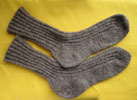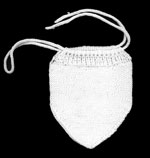
These socks are representative of many. I usually make each pair of socks a bit different, these ended up with a ribbed cuff and I extended the ribbing down the top of the foot.
Their distinction is that I had some triple-ply homespun style yarn in natural brown I bought years ago that was just too heavy to work with, especially with stiff, sore joints and aching, crampy muscles.
I decided to try to "un-ply" the yarn -- somewhat risky as sometimes too much twist causes the knit fabric to skew or the yarn can fall apart if the plies are not twisted enough. I found that the single ply was just about perfect weight for socks. They worked quite well worn with my favorite Doc. Martin's sandals well into June.
The season began with replacing the worn heels and toes of a number of old favorite socks, both ones I made and bought. Finding yarn to do this patching required going through my yarn stash. From what I found I made a number of oversize mittens which I wore over lighter weight mittens. Dressing in layers is a survival skill here in Wisconsin, but this was the first I had applied that principle to mittens. An added benefit is that when wearing two pairs, I found I could I could get to the post office and back on the scooter in the rain without getting my hands wet.
This winter was a bit harsh and overstayed its welcome by about two months. Memorial Day weekend the temperature only got up to the 40's. There seemed to be quite a number of viruses going around too, so I ended up spending a lot of time indoors knitting socks and mittens, cooking and eating comfort foods, and having nice cups of tea to keep warm. I bought some vintage wool on eBay -- remember Brunswick Fairhaven fingering yarn and Pomfret sport yarn? I discovered that I could get the fine weight (fingering) wool I like for socks and mittens by buying it on cones.

I knit a small purse in the spring of Coats Knit-Cro-Sheen mercerized cotton before getting caught up in crocheting.
I was practicing making a tubular edge on ribbing, so made two of them on 1/4 the number of stitches (the number of stitches in the tube get doubled when you start the ribbing), then joined the two pieces on No. 2 sock needles and knit around until it was three inches long, then started decreasing every second row like the tip of a mitten. When only the eight "border" stitches from the decreases were left, I wove them together on an axis perpendicular to the body of the purse.
I finished by knitting an I-cord and threading it through the tubular edges.

These matching socks and mittens are made from wool I bought on eBay from a weaver who lives in Nova Scotia. It came single ply wound on three spools. Although it was a sport weight wool, I found when I knit the single ply, it skewed and didn't look very good, even after I washed and blocked the swatch.
I made a lazy kate by cutting notches into the top of a cardboard box, then threaded the spools on dowels, laid the dowels in the notches so they would turn freely, and plied the yarn with my spinning wheel. Although the yarn resulting was heavier, I liked it a lot better. The wool is fairly coarse and "hairy" but it makes for an interesting, open texture and they should wear well.
Friends and family, note that August is not too early to get in your orders for Christmas! For socks, stand on a piece of paper in your bare feet or thin socks and get a second person to trace the outline of your foot holding the pen or pencil straight up. Also, measure around your calf, especially if you want a high cuff. For mittens, trace your hand with your fingers relaxed and in the approximate position you want them to occupy in the mittens. Place your thumb away from the fingers, but it doesn't have to be at a 90 degree angle. Please note if the person is a child so I can add an extra half inch for growth. Send the tracings to me by snail mail along with yarn weight and color preferences.
August 2, 2003
Copyright © 2003 by Kathy A. Graff, all rights reserved.